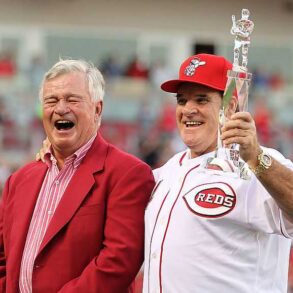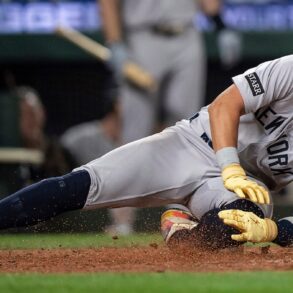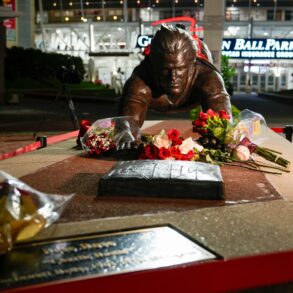
Image credit:
Dean Curley (Photo by Aaron M. Sprecher/Getty Images)
Monday, we rolled out our third mock draft for the 2025 MLB Draft class. Today, we’re diving further into the scouting buzz, rumors and chatter that’s been taking place at the ballpark and over the phone in recent weeks.
Despite it already being May, no one is quite sure who the Nationals are going to take with the first overall pick—including the Nationals themselves. It’s a wide-open race at the top that has only gotten more crowded instead of less in the last few weeks. The most popular names at the top of the board (in no particular order) include Ethan Holliday, Seth Hernandez, Eli Willits and Aiva Arquette.
Let’s push further down the board and get into a number of developing draft storylines. On the slate for today:
Dean Curley Sliding?
Dean Curley entered the season as the most well-rounded hitter in this year’s light college hitting class. He had a strong start to the season and was trending up alongside fellow college shortstops Aiva Arquette (Oregon State) and Marek Houston (Wake Forest). He ranked as a top 10 prospect in our March draft update.
No longer.
Curley slid back into the middle of the first round-range in our April update, and in conversations with scouts over the last few weeks, it sounds like he could keep sliding even further than that.
His surface-level numbers are solid and in line with what he did in 2024. Curley is hitting .303/.421/.510 with 11 home runs, a 16.3% strikeout rate and a 14.2% walk rate. Conference pitching, however, has exposed him a bit more.
In 27 conference games, Curley has a .273/.365/.400 line with a 20.6% strikeout rate and 11.9% walk rate. Evaluators haven’t seen him take the offensive step forward they were expecting in his draft-eligible sophomore season. His .931 OPS is 10th on the team and his .765 conference OPS is fifth.
Compounding his slide are continued defensive concerns. After playing shortstop early in the season, Curley has spent time at third base, second base and DH in recent conference series. He had a pair of tough fielding errors at the hot corner in the ninth inning of an April 25 matchup with LSU that helped allow a comeback victory for the Tigers. Curley hit fifth and played second base for the entire Vanderbilt series last weekend (with two-hit games in all three matchups) and had another throwing error on a wide throw to first from the second base bag.
Andrew Fischer Filling A Pure Hitting Void
While Curley is slipping, Tennessee first baseman Andrew Fischer is moving in the opposite direction. He’s been one of the team’s most productive hitters all spring, and that has continued into conference play, as well.
His overall line sits at .313/.491/.748 with 20 home runs, a 14.5% strikeout rate and a 23.2% walk rate. In conference play, he’s slashing .304/.458/.696 with 10 home runs, an 18.3% strikeout rate and 20.8% walk rate.
Teams are looking for college hitters they have confidence in, and Fischer could fill that void. He has a selective approach, improved contact skills, a short swing that puts the ball in the air to his pull side consistently and plus raw power. No, he doesn’t have the most appealing defensive profile. He’s a likely first baseman who’s not a great athlete in the field and won’t offer much defensive value.
But he hits, and he always has.
The profile could limit how high he goes in the draft, but in this year’s class, it shouldn’t be surprising to see him go somewhere in between the range of James Tibbs (13th) and Blake Burke (34th) from the 2024 class. Fischer has his critics, but he should be an analytical darling. Those most excited about him might hope they can get a Michael Busch-type of outcome.
How Will Teams Separate The Top Tier Of Arms?
A few weeks ago, I wrote that Jamie Arnold was in a tier of his own among college pitchers. I’m no longer sure that’s the case.
Arnold has pitched well throughout the spring. But his season has been more solid than a slam dunk effort of the likes that both Chase Burns and Hagen Smith provided a year ago.
Meanwhile, SEC arms like Kyson Witherspoon, Liam Doyle and Kade Anderson continue to post week in and week out. They are hot on Arnold’s tail and might currently be viewed right alongside him in the top tier of college pitching with a good chance to go inside the first 10 picks of the draft.
Doyle, Anderson and Witherspoon are all among the national leaders in strikeouts and are the top three pitchers in the SEC with their K-BB% rates. Each has continued to build impressive resumes this season. They should each play for teams that have a chance to make deep postseason runs, which will continue to give them opportunities to perform in front of key decision makers.
Below are all four players sorted by strikeout rate:
| player | era | IP | SO | K% | BB% | K-BB% | WHIP | HR/Fb% | FBV |
|---|---|---|---|---|---|---|---|---|---|
| Liam Doyle | 2.17 | 74.2 | 127 | 44.4%% | 8.0% | 36.4% | 0.80 | 10.7% | 95.5 |
| Kade Anderson | 3.66 | 76.1 | 124 | 39.7% | 6.4% | 33.3% | 1.10 | 20.6% | 93 |
| Kyson Witherspoon | 2.45 | 77 | 104 | 33.3% | 6.1% | 27.2% | 0.94 | 7.2% | 96.4 |
| Jamie Arnold | 2.21 | 61 | 82 | 33.1% | 8.5%% | 24.6% | 1.00 | 7.0% | 93.4 |
Riley Quick Surging
It seems like that grouping of four college pitchers is at the top of many team boards—but who’s No. 5?
For many it will be UC Santa Barbara righthander Tyler Bremner, who entered the spring neck and neck with Arnold but has been a bit more inconsistent?
What about hulking, 6-foot-6, 245-pound righthander Riley Quick? He’s been a common name thrown around the industry in recent weeks and seems to be climbing boards. If he’s not solidly in the middle of the first round now, he could be soon.
Quick has a fastball that sits in the 96-97 mph range and is regularly up into the triple digits. For the first time in his career, he’s put together a solid package of innings as a full-time starter. His last three outings have been good ones—seven strikeouts vs. Missouri, nine strikeouts vs. Vanderbilt and seven strikeouts vs. Georgia—and his pure arm talent should rival most pitchers in the class.
Quick hasn’t shown the same strikeout upside that his peers in the class have—his strikeout rate sits at a solid 26.2% in his first 12 starts—but he has made nice strides in the control department.
High Schoolers With Top Three-Round Upside
Here are some quick notes on a handful of high school prospects in the class who are trending up or just getting tons of buzz.
- LHP Uli Fernsler: Fernsler is the player in this group we’re currently the most light on. He’s not ranked on our current draft board but will slot in as a top 100 prospect in our next update. Many teams have second-round grades on him. A 6-foot-4, 215-pound lefthander, Fernsler has an excellent track record as a high-quality strike-thrower and also adds a bit of deception that lets his 89-92 mph fastball play up. His present velocity is overshadowed by others in the class, but scouts alternatively have big grades on his changeup and slider (depending on the scout you talk to). He’ll be 17 on draft day and has a high-probability starter profile.
- 3B Tim Piasentin & RHP Will Hynes: Piasentin and Hynes are the top Canadian prospects in this year’s class. Piasentin is a power-oriented lefthanded hitter who has been getting a lot of attention in recent weeks and puts together impressive BP sessions. He could fit in a similar range as Canadian catcher Nathan Flewelling (Rays, third round) from the 2024 class. Hynes is a 6-foot-2 righthander committed to Wake Forest. He’s been consistent with his outings and throws a fastball in the 91-94 mph range. Scouts believe he has a high-probability starter profile.
- RHP Matthew Fisher: Fisher was one of the biggest risers on our most recent draft update. He’s a 6-foot-3 righthander with a high-spin pitch mix and a fastball that has consistently been in the 92-94 mph range. Age is less critical for high school pitchers, but he will be 19.3 on draft day, which could be a question for some teams.
- OF Blaine Bullard: Bullard was also a notable riser in our last rankings update. He’s had a strong spring season and pairs a clean swing from both sides of the plate with quick-twitch athleticism and strong center field defense.
- LHP Talon Haley: Like Fisher, Haley is older for the class and will be 19.5 on draft day, but more and more teams are viewing him as a top three-round talent in the class. He has pushed his fastball up to 97 mph from the left side and pairs it with a snappy curveball that should be a plus offering.
- OF Josh Owens: If Evan Carter had a full spring season in 2020, perhaps he would have trended like Owens is this year—and wouldn’t have stumped us all on draft day. Owens is a projection infielder with big tools who played football last fall and wasn’t seen at most of the high-profile events on the circuit. He has loud tools, athleticism and pro bloodlines, and his name has become more and more popular as teams have run in and seen excellent BPs and a lot more raw power than they were expecting. Like every high school player mentioned here, it would be unsurprising to see him be selected with a top three round pick.
College Catchers Who Could Push Into Day One
Catchers are difficult to find. Teams always have a need for the position and don’t love digging into the high school demographic to fit that need, since it’s arguably the riskiest demo in the draft. That means college catchers with performance always go in a good spot.
The 2025 draft class has three clear catchers at the top who have good odds to be first-round picks: Ike Irish (Auburn), Luke Stevenson (North Carolina) and Caden Bodine (Coastal Carolina). There’s a tier break after those three, but there are a handful of catchers with excellent seasons who should be pushing to fill the vacuum in the next tier:
Florida catcher Luke Heyman is the most prominent of this group. He was draft-eligible as a sophomore in 2024 and was a touted prep recruit, as well. He ranked as a top 10-round talent a year ago but had a down season and didn’t get selected. That won’t be the case this year. Overall, he’s hitting .301/.394/.578 with 13 home runs with a career-low 18.7% strikeout rate and career-high 10.8% walk rate. His in-conference numbers are even better. He leads all Florida hitters with a 1.147 conference OPS. His conference line is .322/.413/.733, and 10 of his 14 home runs have come in conference play.
Troy catcher Brooks Bryan played with USA Baseball’s college national team in 2024 and entered the spring well regarded for his defensive work. He did have some contact questions, however. While those contact questions still exist, Bryan has followed up on a solid 2024 sophomore season with another solid one in 2025, hitting .286/.407/.557 with 12 home runs, a 25.6% strikeout rate and a 13.4% walk rate. Even with some pure hit tool questions, Bryan seems to be a strong enough defensive catcher with above-average arm strength and some power to warrant a top three-round pick.
The biggest pop up name in this tier is Richmond backstop Jack Arcamone. Through 49 games, Arcamone is hitting .360/.463/.677 with 12 home runs, 21 doubles, a 23.3% strikeout rate and a 15% walk rate. Teams have been scrambling to get looks at him this spring because his performance—and underlying batted ball data—is so loud. Teams that put a lot of stock in history might be more conservative with Arcamone on draft day, but my guess is his position, 2025 performance and loud exit velocity data will push him a few rounds higher than where many scouts have him graded.
This post was originally published on this site be sure to check out more of their content.





